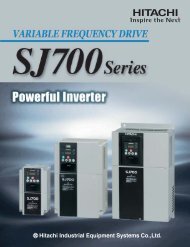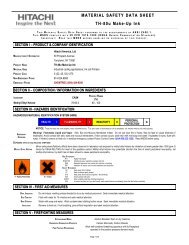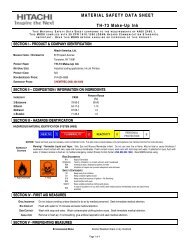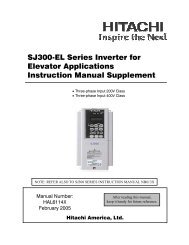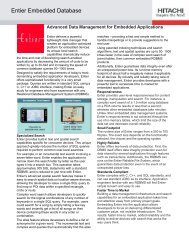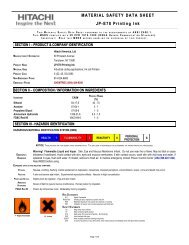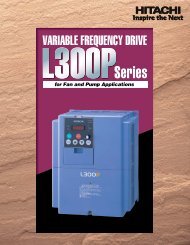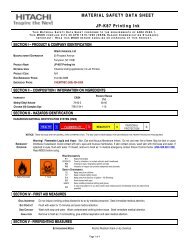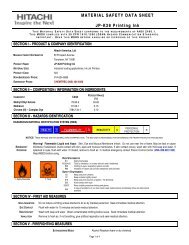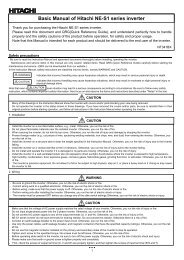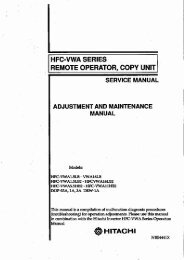SJ700-2 Instruction Manual NT204DX - Hitachi America, Ltd.
SJ700-2 Instruction Manual NT204DX - Hitachi America, Ltd.
SJ700-2 Instruction Manual NT204DX - Hitachi America, Ltd.
Create successful ePaper yourself
Turn your PDF publications into a flip-book with our unique Google optimized e-Paper software.
Chapter 4 Explanation of Functions<br />
4.2.17 V/F characteristic curve selection<br />
The V/F characteristic curve selection function allows you to set<br />
the output voltage/output frequency (V/f) characteristic.<br />
To switch the V/F characteristic curve selection among the 1st,<br />
2nd, and 3rd settings, assign function "08" (SET) and "17"<br />
(SET3) to intelligent input terminals. Use the SET and SET3<br />
signals for switching.<br />
Related code<br />
A044/A244/A344: V/F characteristic curve<br />
selection, 1st/2nd/3rd motors<br />
b100/b102/b104/b106/b108/b110/b112:<br />
Free-setting V/f frequency (1) (2) (3) (4) (5) (6) (7)<br />
b101/b103/b105/b107/b109/b111/b113:<br />
Free-setting V/f voltage (1) (2) (3) (4) (5) (6) (7)<br />
Function code Data V/f characteristic Remarks<br />
00 Constant torque characteristic (VC)<br />
01<br />
Reduced-torque characteristic<br />
(1.7th power of VP)<br />
02 Free V/f characteristic Available only for A044 and A244<br />
A044/A244/<br />
A344<br />
Sensorless vector control (SLV) Available only for A044 and A244 (See Section<br />
03<br />
4.2.96.)<br />
04<br />
0 Hz-range sensorless vector Available only for A044 and A244 (See Section<br />
control<br />
4.2.97.)<br />
05 Vector control with sensor (V2) Available only for A044<br />
(1) Constant torque characteristic (VC)<br />
With this control system set, the output voltage is in proportion to the output frequency within the range<br />
from 0 Hz to the base frequency. Within the output frequency range over the base frequency up to the<br />
maximum frequency, the output voltage is constant, regardless of the change in the output frequency.<br />
Output voltage<br />
(100%)<br />
0<br />
Base<br />
frequency<br />
Maximum<br />
frequency<br />
Output frequency (Hz)<br />
(2) Reduced-torque characteristic (1.7th power of VP)<br />
This control system is suited when the inverter is used with equipment (e.g., fan or pump) that does not<br />
require a large torque at a low speed.<br />
Since this control system reduces the output voltage at low frequencies, you can use it to increase the<br />
efficiency of equipment operation and reduce the noise and vibrations generated from the equipment.<br />
The V/f characteristic curve for this control system is shown below.<br />
Output voltage<br />
(100%)<br />
VC<br />
VP(f 1.7 )<br />
0<br />
10% of base<br />
frequency<br />
Base<br />
frequency<br />
Maximum<br />
frequency<br />
Output frequency (Hz)<br />
a b c<br />
Period a : While the output frequency increases from 0 Hz to the 10% of the base frequency, the<br />
output voltage follows the constant torque characteristic.<br />
(Example) If the base frequency is 60 Hz, the constant torque characteristic is maintained<br />
within the output frequency range of 0 to 60 Hz.<br />
Period b : While the output frequency increases from the 10% of base frequency to the base<br />
frequency, the output voltage follows the reduced-torque characteristic. In other words, the<br />
output voltage increases according to the 1.7th power of the output frequency.<br />
Period c : While the output frequency increases from the base frequency to the maximum frequency,<br />
the output voltage is constant.<br />
4 - 16



